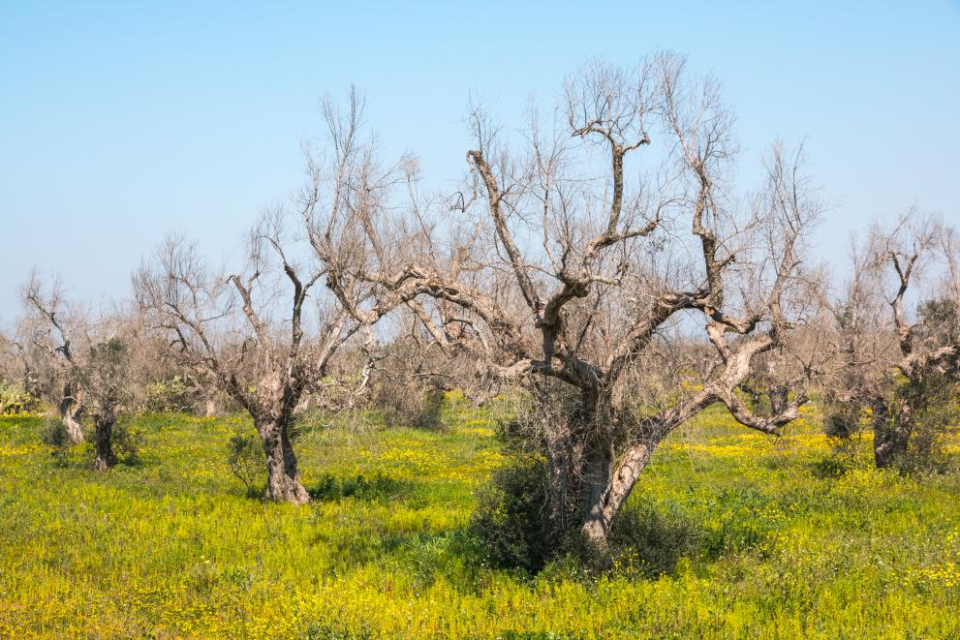Gepubliceerd op 5 oktober 2023
In olive groves, Xfp can cause ‘olive quick decline syndrome’ (OQDS), which incites leaf, twig and branch die-back followed by final tree collapse. The disease, which typically spreads from late spring into summer, is transmitted through the xylem-sap-feeding activity of the meadow spittlebug insect (Philaenus spumarius).
Currently, more than 6.5 million olive trees have been infected by Xfp in the Salento area of Apulia, Italy. Field control of the disease is difficult, given that the bacterium can survive and multiply in the xylem tissue of plants. Regulation aims to reduce bacterial spread by eradicating infected trees and plants, with some regions of Salento designated as either ‘infected’ or ‘containment’/‘buffer’ zones.
Current policy in the area also aims to reduce the number of meadow spittlebug eggs and juveniles by mechanically removing weeds in early spring, and to limit the spread of adult insects by spraying pesticides on olive tree crowns. These policies are mandatory in infected, containment and buffer zones, and are strongly recommended in areas that are not yet infected, where farmers have been offered economic incentives and encouraged to plant cultivars that are more resistant to Xfp infection.
Despite massive tree eradication and pesticide use, Xfp continues to spread. The affected ecosystem – the nine-million-hectare evergreen woodland of the Mediterranean basin – can make crucial contributions to climate mitigation and regulation, with olive agro-ecosystems demonstrating a promising capacity to sequester carbon dioxide in their trunks, branches, roots and underlying soil. This is especially relevant in southern Italy, which is experiencing increasing desertification that is threatening not only the environment, but also agricultural livelihoods and economic stability.

Previous research has explored sustainable control strategies for Apulia to reduce Xfp prevalence and OQDS symptoms, with experimental fields in Salento using a restoration strategy based on bio-fertiliser. In these fields, a zinc-copper-citric acid fertiliser was sprayed on olive tree crowns, applied monthly since 2016 from spring to early autumn.
Two of Europe’s Earth-observing satellites, Copernicus Sentinel-2 and Pléiades support many remote sensing services, from water-quality monitoring to emergency management. Using multi-resolution data from the two satellites, the study aimed to evaluate the effectiveness of this bio-fertiliser at both field and tree scales for Salento.
The researchers first analysed spectral vegetation trends from high resolution (HR) Sentinel-2 data (gathered annually in July and August from 2015–2020 at field scale), comparing values for treated and untreated trees over time and exploring any possibly correlated weather events (e.g. reduced rainfall, heat waves). They then evaluated the response of different cultivars to treatment at tree scale using very high resolution (VHR) data from Pléiades.
The researchers compared four indices captured by the Sentinel-2 data with two captured by the Pléiades data to detect changes induced by restoration action at field scale.
All indices were higher in treated than untreated fields, implying a higher degree of difference following treatment. For example, the NDVI (normalised difference vegetation index), which is used to quantify the difference in vegetation density or ‘greenness’ of the landscape, was higher in the treated than in the untreated conditions.
At field scale, the HR analysis (Sentinel-2) showed that olive trees could reduce their bacterial load after two years of treatment, becoming productive again after three years of treatment. The VHR data (Pléiades) revealed the response of different cultivars to the bio-fertiliser, with the Oliarola Salentina variety responding better to treatments than Leccino or Cellina varieties. All findings aligned with supporting in-field DNA sampling analysis that confirmed the presence of the pathogen.
These results could support optimisation of bio-fertiliser dosing and help local farmers to improve the effectiveness of the zinc-copper-citric acid fertiliser restoration action, including by planting more resistant cultivars.
Source:
European Commission. (2023, October 4). EU satellites reveal how bio-fertiliser can protect the olive groves of southern Italy. Energy, Climate Change, Environment.